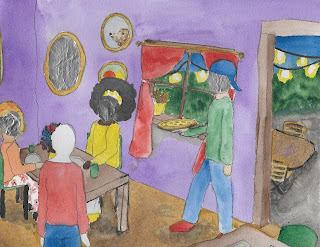This reading created an absolute tug-of-war inside of me.
Shalaby discusses Troublemakers in a book of the same name. Learning from students who are labeled "defiant," who are the "tough kids," Shalaby seeks to change how teachers see these students from a deficit- to an asset-based lens. Instead of problems, Shalaby asks that we see leaders.
This rings true for me, but with access only to the preface and introduction, I feel lost on how to negotiate this concept within my practice. I agree with the perspective, but I do not understand the practice within the limitations of the current schooling system. How can you have 25+ troublemaker/leaders in a room and not end up with fist fights? How do you channel that energy into productive struggle instead of violence (speaking from experience running true choice based art classes)? How do you teach and encourage "good trouble?" What do you do when students don't rise to the challenges associated with autonomy?
While Shalaby argues that power needs to be handed to students, I think back to Delpit's conversations with learners who felt that teachers needed to use their power more to develop students. These learners talked about teachers who couldn't control their classrooms and who left students disadvantaged due to lack of direct instruction, a style of teaching that relies on the teacher exerting explicit power as the authority of the topic and the primary voice for the lesson. Students felt their learning was disrupted by teachers who were trying to distance themselves from power (even though they never truly did, as we discussed in class). These are contrasting voices with the same goal. Both authors argue for changing the system, with Shalaby seeming to advocate for an immediate change while Delpit seems more pragmatic about equipping students within the system as it exists and changes occur over time.
The system really is heartbreaking, however. How do we address that school really is not about learning? I grew up homeschooled and I constantly struggle with this as a teacher. School absolutely is about sitting in one spot for 8 hours, listening to someone else talk, and obeying. I did my work in 3-4 hours and graduated high school while carrying a large amount of responsibility for younger siblings, went on to be a founding member of a non-profit in Africa, then returned to get a double major and a minor in undergrad with a 3.95 GPA, and am getting good grades in my graduate studies. My alternative schooling pre-K through high school is a major factor in my successes in formal education and the long list of things I have achieved in my career and personal life. I did not have to sit still for 18 years. I could take breaks. I managed my own time. I could include my own interests. I could spend time with siblings, friends, and an extended community network of all ages, backgrounds, and interests. I regularly spent 3-4 hours a day hanging out with friends online from around the world. I had the freedom Shalaby advocates for and the intrinsic motivation to make the most out of it. But I'm not an amazing outlier - I'm proof there are better systems.
But this can't be provided in a traditional school setting. Behavior has to be managed because every student deserves to be safe from verbal and physical violence, and the social-emotional skills gap that makes it likely that freedom will cause broken bones is real. Kids are sardines in a factory and can't get out and this pressure absolutely has a negative influence, but we also can't let them out because then what? Homeschooling is clearly not an option for most when households already can't survive on two incomes. Adding more SEL is important, but does it really resonate with students? Smaller classrooms sounds great, but it's still mandatory and highly controlled, meaning that there will still be "problem" students causing real problems as they resist systems that are not designed for them to thrive.
Some kind of hybrid is needed that does meet the needs of the population for childcare, that allows parents to work, that provides students with autonomy and safety, and that gives them authentic learning opportunities. Unfortunately, I feel like this blog post is something more like a rant than an answer to this puzzle, but it's what I have for today.
I will say, I have come across some resources that are helping me tease apart different viewpoints to try and get closer to an ideal system where students want to learn, want to lead, can authentically exercise autonomy, and surpass expectations. I'm just still in the process of internalizing it and applying it to my context. Still, I can highly recommend @teachingtoariot and @aishforashlyn on Instagram for helping me branch out in my thinking and explore new ways to approach my practice.
For now, however, I'm going to keep trying Delpit's approach. I'm going to pragmatically work within the current schooling system while giving students all the tools I can to learn, grow, and develop mature autonomy so that they can use freedom for causing "good trouble." I'll definitely have some students calling me a dictator while others think I'm too soft. But for today, it's what I have to offer my students, and I have faith that it is enough to show up while in the process of learning, unlearning, and growing.

.jpg)



Looking forward to exploring those resources you shared. Keep looking for good trouble, Abi. It is worth the journey.
ReplyDelete